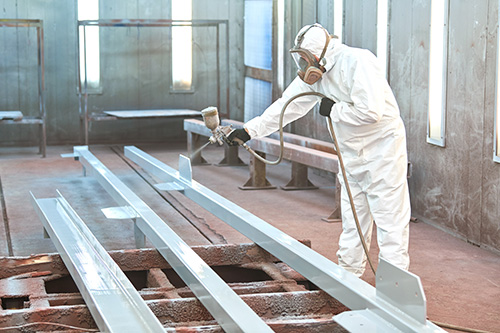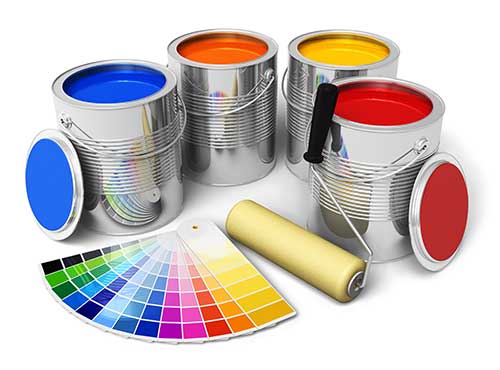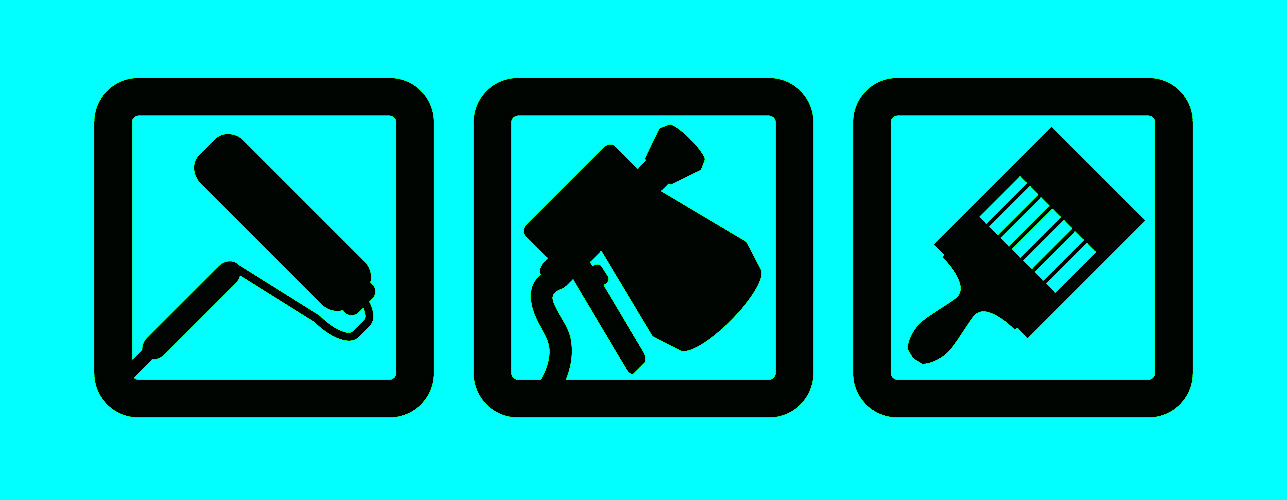Industrial Metal Painting

From the medical field to an automotive or industrial facility, every metal requires some sort of coating to protect the equipment from corrosion. Every aspect of painting the metal needs to be carefully considered and planned such that the performance is not affected.
This article brings to you everything you need to know about industrial metal painting, different types of industrial metal paints, coatings, best industrial paint, preparation, the process of painting metal, and much more.
Industrial Metal Painting
Industrial metal paints are products presented in powder, liquid, or paste form. When applied by a suitable process, they form a solid, adhesive film that protects and decorates the surface. In the industrial field, they are involved in the maintenance and conservation process of any structure or consumer goods associated with the manufacturing sector.
Their applications include marine, military, medical, pharmaceutical, optical, textile, and semiconductor. Depending on the paint, you can apply them with a brush, roller, or spray system.
Types of Industrial Metal Paints
Industrial metal paints are comprised of solvent, resin, pigments, and sometimes diluents. Depending on the composition, the metal paint may either be solvent-based (contains volatile organic compounds (VOC) as a carrier) or water-based (has mostly water but can also include alcohols and glycol ethers as a carrier).
The different types of metal paint include:
- Acrylic – A synthetic resin used exclusively in water-based paint and is suitable for use in metal, glass, ferrite, plastics, and oily surfaces.
- Epoxy – Handles environmental degradation better than other resins such as alkyds; hence used in aircraft components.
- Polyurethane – Tough, rubber-like elastomer based on the condensation of organic isocyanates with resins containing hydroxyl groups
- Polyester – Generally unsaturated and standard in marine applications
- Inorganic or Silicate – Uses titanium dioxide as an extended pigment.
- Polytetrafluoroethylene (PFTE) – Engineering plastics characterized by high thermal stability. Chemical resistance and low friction.
Types of Industrial Metal Coatings
Industrial paint coatings are a special protective coating that protects the machinery from corrosion and prevents further damage.
Solvent Based Coating: They are essentially paints that give a heavy-duty color to your metal. Solvent-based coatings create a protective layer over the metal, protecting it from humidity, acid, salt, oil, and abrasion. For a high-quality, long-lasting effect, use a combination of urethane topcoat, e-coat, and an epoxy primer.
Waterborne Coating: Waterborne coatings are generally non-toxic, non-flammable, non-hazardous, and safe for the environment. Apart from that, they are also fade-resistant with good color retention. They are one of the best options since they are 100% compliant with clean air regulations.
Powder Coating: Powder coatings offer protection and improve aesthetics. They can be customized according to industrial needs. You can choose the thickness, hardness, UV protection, and chemical resistance.
Anti-Fouling Coating: Anti-fouling coating is tin-free, long-lasting, cost-effective, and easy to apply. They work in a variety of applications, especially in boats, both in fresh and saltwater conditions.
E-Coating: E-coating is the process of dipping products in paint and then electrified, to create adhesion. This allows for highly targeted thickness. They perform well as a primer and as a topcoat providing superior adhesion and UV protection. It coats hard-to-reach areas since
CARC Coating: Chemical Agent Resistant Coating, otherwise called CARC coating, is highly specialized and developed, particularly in military applications. It is non-porous, non-absorbant, and resistant to chemical and biological agents.
Industrial Coatings Method
There are several methods of protecting the industrial surfaces, each one vastly different from the rest. The most commonly used industrial coatings methods are as follows:
Painting – The most common and popular industrial coating can be applied as e-coating, powder coating, or liquid.
Hot Dipping – Also called galvanizing, it involves dipping steel into hot zinc, creating zinc oxide, which is resistant to corrosion.
Chemical Process – Chemical process involves creating a thin film of sulfide and oxide through a chemical reaction.
Anodizing – The anodizing process increases the aluminum oxide making it resistant to corrosion. This method provides a more adhesive surface to other further coatings.
Electroplating – It is the method of immersing a metal in a bath containing cadmium, nickel, or chromium and running an electrical current through it.
Porcelain Enamel – Often used in cast iron cookware, it protects the products against scratches.
Best Paint for Metal Surfaces

Oil-based paint is the best paint for industrial metal surfaces. Though expensive than water-based paints, they are formulated with pigments, synthetic resins or plant-based oil, and solvents. When cured, it dries to a rigid coat that repels water, dents, and scuffs.
On the downside, the color also tends to fade; hence your selection should have built-in fade-in protection.
While you can apply oil paint directly on the metal surface, it may take as long as 8 hours to dry. Hence an oil-based primer is necessary for a more uniform finish and a fast job. Additionally, you may want to choose one with heat-resistant resins if the machinery is subjected to high temperatures.
Best Industrial Paint for Metal
Metal doors have significant benefits in terms of security, weather protection, etc. They are also long-lasting and are built to withstand the elements.
Here are some of the best metal paints available in the market:
- Seymour High Solids Spray Paint: A industrial-grade aerosol paint that dries to a hard layer and resistant to nicks, heat, and high humidity;
- Rust Bullet Automotive Rust Inhibitor Paint: Protected by two patents; Oil-based; UV resistant;
- Rust-Oleum Hammered Paint: Oil-based formula that is weather and corrosion resistant; hammered metal finish; Dries in 2-4 hours;
- Krylon ColorMaster Paint and Primer: Available in matte, flat, metallic, gloss, and satin finishes. dries in 10 minutes;
- Rust-Oleum Protective Enamel: Spray paint; Oil-based with a glossy finish. Doesn’t dry fast but lasts long;
Prep Work for Metal Painting
Prep work constitutes more than half of the paint job when it comes to metal. It requires a lot of elbow and grease to prepare the surface. Metal is one of the trickiest areas to paint since the latter doesn’t stick as it does with any other surfaces. Hence without proper preparation, the results are more likely to be disappointing.
Checklist
- To start with, wear a dust mask and work in a well-ventilated area.
- Clean the surface with a detergent solution and water to remove the dust, dirt, and grime. This process improves the adhesion, and the paint goes on more smoothly. In the case of exterior painting projects, you may need to pressure wash.
- Use a wire brush to remove the rust and other surface imperfections.
- After removing the rust and old paint, use a sanding block or fine-grit sandpaper to sand the metal.
- Use a damp cloth to clean the sanding dust off the metal. Wait for it to dry before priming.
- Step 1 also applies to new metal since it has a coating that needs to come off. In this case, skip to step-6 after step-1.
- Use a specially formulated metal primer to prime the surface. Choose the medium depending on the surface area. If it has an uneven surface with nooks and crannies, go for a spray primer. Otherwise, you can use a brush or a roller. The process is similar to that of painting.
- Your primer requires 24 hours to dry or according to the manufacturer’s instructions.
Experts suggest two types of primers for metals: Rust converter (which prevents rust from reoccurring) and galvanized metal primer (suitable for metals that are difficult to paint). Apart from this, you also have iron oxide and zinc chromate primers which can be used on all metals, including iron and steel.
Metal Primer: Is it Necessary?
While a primer isn’t always necessary, without it, the metal can oxidize, leading to corrosion and inevitable decay. Moreover, the paint doesn’t adhere to the metal surface without the primer causing it to flake off easily.
Experts recommend using primer, especially if it comes into contact with moisture. In this case, the primers will contain anti-corrosive or anti-rust materials.
How to Paint Industrial Metal
A fresh coat of paint can do wonders to the metal, whether it is industrial or household. Not only does it brighten, but it also prolongs the life of the metal. As always, you need a few materials, a little bit of technique, and you are away painting.
Tools: Brush/ roller, paint, or spray paint
Here are the steps to follow when painting metal.
- Start by prepping and priming the surface you intend to paint. Do not forget to wear a dust mask as you do the prep work.
- Depending on the surface, you can either use a brush, roller or even spray paint. The paint you choose should be specially formulated for metal or all-purpose.
- Ensure that you apply 2 – 3 coats and let the paint dry for a few hours between each layer. (It is a good idea to proceed with thin layers)
- Once you are happy with the coverage, let it dry for about eight hours or overnight if possible.
- As the final step, use a lacquer sealer to paint-job, not only to protect but also to impart a beautiful shine.
Best Way to Paint a Metal Surface: Brush, Roller, or Spray Paint?

Spray painting is easier than any other method; however, it deposits a thin layer of paint. Experts suggest that you do at least three thin coats allowing the paint to dry between each coat for best results.
Talking about the brush creates a thick coat, giving a lasting finish much better than spray paint. However, the paint may be too thick and would need mineral spirits to dilute.
On the downside, it takes 36-48 hours to cure with a brush painting.
How to Paint a Metal Door
Metal doors like steel are built to keep the heat and cold out of our homes. Not just that, it can also elevate the curb appeal of your home. However, they will require a coat of paint or two at some point in their lifetime.
As with any painting project, the metal door will require proper prep work as the final result depends on the preparation. Following the below instructions can ensure that the paint job lasts longer and look great for years to come.
- Remove the metal door from its hinges and cover the hardware (anything you wish to protect).
- Clean the door using a mild detergent solution and water.
- Use a wire brush to remove any rust. Do not forget to wear a dust mask to protect yourself).
- Lightly sand with fine-grit sandpaper and wipe it clean with a damp cloth.
- Ensure that there are no traces of old paint.
- Once the door is clean, apply two coats of primer, letting each coat dry in between.
- Apply two coats of either exterior satin or semi-gloss paint.
- Let the paint dry, and then rehang the door.
Conclusion
Metal painting is quite demanding to start with. However, with the proper preparation and tools, you should be able to paint without any issues, even for a beginner.
However, painting industrial products are quite different since corrosion requirements and other regulations govern them. It can be pretty challenging to identify which paint and coating are suitable for your situation. In this case, it is safer to approach a professional to paint your machinery. They can develop a highly customized coating considering the durability, capability, and flexibility.

If you are looking for a stress-free commercial or industrial painting experience, you need to choose the right contractors – contact Nelson Greer Painting Contractors for your FREE quote today. We will make sure that your home is properly painted inside and out to last you for years to come. With over 220 years of experience in our company’s history, you’ll love what we can do with our professional painting contractors.
Categories
- Church Painting (1)
- Commercial Painting (12)
- Exterior Painting (4)
- Interior Painting (2)
- FAQ (1)
- Floor Coating & Sealing (1)
- General (13)
- Industrial Painting (1)
- Metal Painting (1)
- Paint Prep (3)
- Painting Contractors (4)
- Pool Deck Epoxy (1)
- Residential Painting (32)
- Baseboards & Trim (2)
- Cost (3)
- Exterior Painting (8)
- Interior Painting (7)
- Tips (2)
- Walls (6)
- Roof Replacement (1)